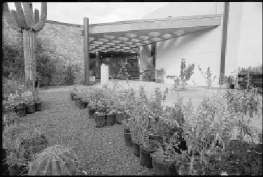College of Agriculture, University of Arizona, Arizona
Land and People, Vol. 46, Number 1
Other Research Facilities
Boyce Thompson Southwestern
Arboretum
 Situated
on the edge of the low desert near Superior, Arizona, this public botanic
garden is a two-hour drive from the UA campus. Thirty-eight acres of
native and introduced plants from arid and semi-arid regions, together
with about 1,000 addi- tional acres of undisturbed fauna and flora,
are under Arboretum control. Additionally, large tracts of relatively
undisturbed habitats in a variety of biomes lie in the surrounding Tonto
National Forest. Situated
on the edge of the low desert near Superior, Arizona, this public botanic
garden is a two-hour drive from the UA campus. Thirty-eight acres of
native and introduced plants from arid and semi-arid regions, together
with about 1,000 addi- tional acres of undisturbed fauna and flora,
are under Arboretum control. Additionally, large tracts of relatively
undisturbed habitats in a variety of biomes lie in the surrounding Tonto
National Forest.
This facility is operated cooperatively by The University of Arizona
College of Agriculture, the Arizona State Parks Board, and the Boyce
Thompson Southwestern Arboretum Board. The Arboretum has facilities
for teaching and research – laboratory facilities and housing are available.
The Arboretum is open daily from 8:00 a.m. to 5:00 p.m. except for Christmas
Day.
For more information, contact Arboretum Affairs
37615 E. Highway 60 Superior, AZ 85273 (520) 689-2723 Web site: http://ag.arizona.edu/BTA
|
|
Spotlight: The Desert Legume
Program
The Desert Legume Program (DELEP) was started in 1988 by R. Phillip
Upchurch as a cooperative project of the Boyce Thompson Southwestern
Arboretum and The University of Arizona College of Agriculture. The
program was established for three reasons:
- to develop a comprehensive seed bank of species in the legume family
(Leguminosae or Fabaceae) indigenous to or adaptable to arid and semi-arid
regions of the world,
- to conduct ongoing investigations into the utility of these plants,
and
- to make seed samples available to people and organizations working
with these plants.
 DELEP
focuses on legumes for several reasons. Leguminosae is a large plant
family containing more than 18,000 species that provide food, medicines,
fuelwood, lumber, livestock forage and feed, soil stabilization and
improvement, and landscaping around the world. Many species of legumes
are threatened with extinction, diminishing the earth’s genetic diversity.
Although legumes are often well-represented in the floras of arid and
semi-arid regions of the globe, no comprehensive collection of arid-land
legumes has been undertaken before. DELEP
focuses on legumes for several reasons. Leguminosae is a large plant
family containing more than 18,000 species that provide food, medicines,
fuelwood, lumber, livestock forage and feed, soil stabilization and
improvement, and landscaping around the world. Many species of legumes
are threatened with extinction, diminishing the earth’s genetic diversity.
Although legumes are often well-represented in the floras of arid and
semi-arid regions of the globe, no comprehensive collection of arid-land
legumes has been undertaken before.
 The
seed collection currently includes more than 2700 accessions representing
approximately 1200 species. DELEP acquires seed from wild and cultivated
sources, and through donations, exchanges and purchases. Seeds of each
species are germinated and grown out to determine their horticultural
requirements at field plots at the UA Campus Agricultural Center in
Tucson, and at the UA Yuma Mesa Agricultural Center. Many species are
also planted in exhibits at the Boyce Thompson Southwestern Arboretum
near Superior, Arizona. The
seed collection currently includes more than 2700 accessions representing
approximately 1200 species. DELEP acquires seed from wild and cultivated
sources, and through donations, exchanges and purchases. Seeds of each
species are germinated and grown out to determine their horticultural
requirements at field plots at the UA Campus Agricultural Center in
Tucson, and at the UA Yuma Mesa Agricultural Center. Many species are
also planted in exhibits at the Boyce Thompson Southwestern Arboretum
near Superior, Arizona.
Volunteers play a key role in DELEP and actively participate in many
aspects of the program. A quarterly bulletin, Aridus, is available
at no cost. In addition to the seed bank and field evaluation trials,
DELEP provides plant material for pharmaceutical research projects,
and works closely with members of the Arizona landscape nursery industry
to make new landscape plants available.
For more information, contact Desert Legume
Program 2120 East Allen Road Tucson, AZ 85719 (520) 318-7047
|